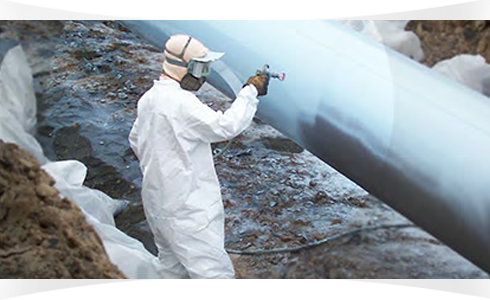



The application and maintenance of anticorrosion protection is one of the most important aspects affecting pipe manufacturing, laying and operation of pipelines. The two essential components of pipeline protection are: Anticorrosion Coatings and Cathodic Protection. Both are vital to ensuring the long life and operating safety of long pipelines.
Depending on the plant configuration, the following types of external coatings may be applied:
Fusion–bonded powder coatings (FBE)
Multi–layer extruded polyolefin such as polyethylene (PE) or polypropylene (PP) coatings — the latter has found substantial use in high–temperature and offshore applications. An epoxy anti–corrosion primer is applied to the pipe. It adheres to a normally non–compatible mechanical outer layer of polyethylene or polypropylene by means of an adhesive layer. This system arose in response to the perceived vulnerability of strictly epoxy coated systems.
Multi–component epoxy and polyurethane coatings — epoxy coating is available in either “thin film” or double layer. The epoxy is the anti–corrosion agent.
Hot tape coatings — iInclude the use of heat shrink tape as well as the Vanguard® three–layer tape system and the Synergy® hot tape system. Vanguard, sometimes called “three–layer in a tape”, produces a DIN compliant three layer coating when the tape is fused onto the pipe surface. Factory–applied tape systems allow the pipe coater to avoid expensive purchases of extrusion and other equipment normally associated with three–layer PE or PP coatings.
Hot enamel coatings — coal tar or bitumen/asphalt coatings are applied in molten form with wraps of fiberglass and other felt tapes. While the coating life is excellent, HSE (health, safety and environment) concerns have diminished their use over time.
In addition, internal coating materials may be applied including:
Fusion–bonded powder coatings
Multi–layer epoxy and polyurethane coatings
Cement–mortar lining
Coal tar and modified coal tar coatings